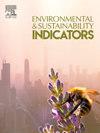利用地理空间分析评价埃塞俄比亚裂谷Ziway湖流域地下水补给潜力:基于GIS和ahp的方法框架
IF 5.4
Q1 ENVIRONMENTAL SCIENCES
引用次数: 0
摘要
地下水是不可缺少的资源;然而,它在空间和时间上的分布变化很大,在确定和绘制可靠来源方面提出了重大挑战。这一挑战在位于埃塞俄比亚主裂谷(MER)内的Ziway湖流域(ZLW)尤为明显,该地区水文地质复杂,地质构造多样,土壤性质各异,降雨模式不一致。因此,本研究旨在通过地理信息系统(GIS)和层次分析法(AHP)相结合的方法,识别和优选中下游地下水补给潜力区,以支持地下水可持续管理。利用GIS对降雨、岩性、高程、地形密度、坡度、土地利用/土地覆盖、土壤质地、归一化植被指数、蒸散发和排水密度等关键因素进行了分析。采用层次分析法对各因素的相对重要性进行评价,并基于GIS技术进行叠加分析,得到补给电位区图,并通过受者工作特征曲线分析对其进行验证。结果确定了5个地下水补给区:极低(18.05%)、低(23.61%)、中(21.89%)、高(19.64%)和极高(16.81%)。超过58%的流域显示出中等到非常高的地下水补给潜力,突出了地下水资源管理以应对环境挑战的关键领域。结果表明,降雨和岩性是控制地下水补给潜力的最重要因素。本研究通过确定造林地点,为埃塞俄比亚“绿色遗产倡议”的水资源政策和规划提供了见解,并在地方和全球范围内促进了环境可持续性和气候变化适应战略。本文章由计算机程序翻译,如有差异,请以英文原文为准。
Evaluation of groundwater recharge potential using geospatial analysis in the Ziway lake watershed, Ethiopian Rift: A GIS and AHP-Based methodological framework
Groundwater is an indispensable resource; however, its highly variable distribution in space and time presents significant challenges in identifying and mapping reliable sources. This challenge is particularly evident in the Ziway Lake watershed (ZLW), situated within the Main Ethiopian Rift (MER), characterized by complex hydrogeology, featuring diverse geological formations, varying soil properties, and inconsistent rainfall patterns. Therefore, this study aims to identify and prioritize groundwater recharge potential zones within the ZLW to support sustainable groundwater management by integrating geographical information systems (GIS)and the analytical hierarchy process (AHP) methods. Key factors, including rainfall, lithology, elevation, lineament density, slope, land use/land cover, soil texture, normalized difference vegetation index, evapotranspiration, and drainage density, were analyzed using GIS. AHP was employed to assess the relative importance of these factors, and GIS based overlay analysis was applied to produce recharge potential zone map, which was validated through Receiver Operating Characteristic curve analysis. The results identified five groundwater recharge zones: Very low (18.05 %), low (23.61 %), moderate (21.89 %), high (19.64 %), and very high (16.81 %). Over 58 % of the watershed exhibits moderate to very high groundwater recharge potential, highlighting critical areas for groundwater resource management to address environmental challenges. The sensitivity of the factors utilized was assessed, showing that rainfall and lithology are the most essential factors controlling groundwater recharge potential in the region. This study provides insights for water resource policy and planning for Ethiopia's Green Legacy Initiative by identifying afforestation sites, and promotes environmental sustainability and climate change adaptation strategies at local and global scales.
求助全文
通过发布文献求助,成功后即可免费获取论文全文。
去求助
来源期刊

Environmental and Sustainability Indicators
Environmental Science-Environmental Science (miscellaneous)
CiteScore
7.80
自引率
2.30%
发文量
49
审稿时长
57 days
 求助内容:
求助内容: 应助结果提醒方式:
应助结果提醒方式:


